1998 CHEVROLET EXPRESS air conditioning
[x] Cancel search: air conditioningPage 86 of 386

Downloaded from www.Manualslib.com manuals search engine A CA JTAN:
It can be dangerous to drive with the rear doors
open because carbon monoxide
(CO) gas can
come into your vehicle. You can’t see or smell
CO. It can cause unconsciousness and even death.
If you must drive with the rear doors open or if
electrical wiring or other cable connections must
pass through the seal between the body and the
rear doors:
Make sure all windows are shut.
I’urn the fan on your heating or cooling
system to its highest speed with the setting
on VENT, HEAT, BLEND or
DEF.
Additionally, on vehicles with heatindair
conditioning
systems, NORM A/C or
BI-LEVEL A/C can be used. That will
force outside air into your vehicle. See
“Comfort Controls” in the Index.
If you have air outlets on or under the
instrument panel, open them all the way.
See “Engine Exhaust” in the Index.
Theft
Vehicle theft is big business, especially in some cities.
Although your vehicle
has a number of theft-deterrent
features, we know
that nothing we put on it can make it
impossible to steal. However, there are ways
you can help.
Key in the Ignition
If you leave your vehicle with the keys inside, it’s an
easy target for joy riders or professional thieves
-- so
don’t do it.
When you park your vehicle
and open the driver’s door,
you’ll hear a tone reminding you
to remove your key from
the ignition and take it with
you. Always do this. Your
steering wheel will be locked, and
so will your ignition
and transmission. And remember
to lock the doors.
Parking at Night
Park in a lighted spot, close all windows and lock your
vehicle. Remember
to keep your valuables out of sight.
Put them in a storage area, or take them with you.
Page 104 of 386
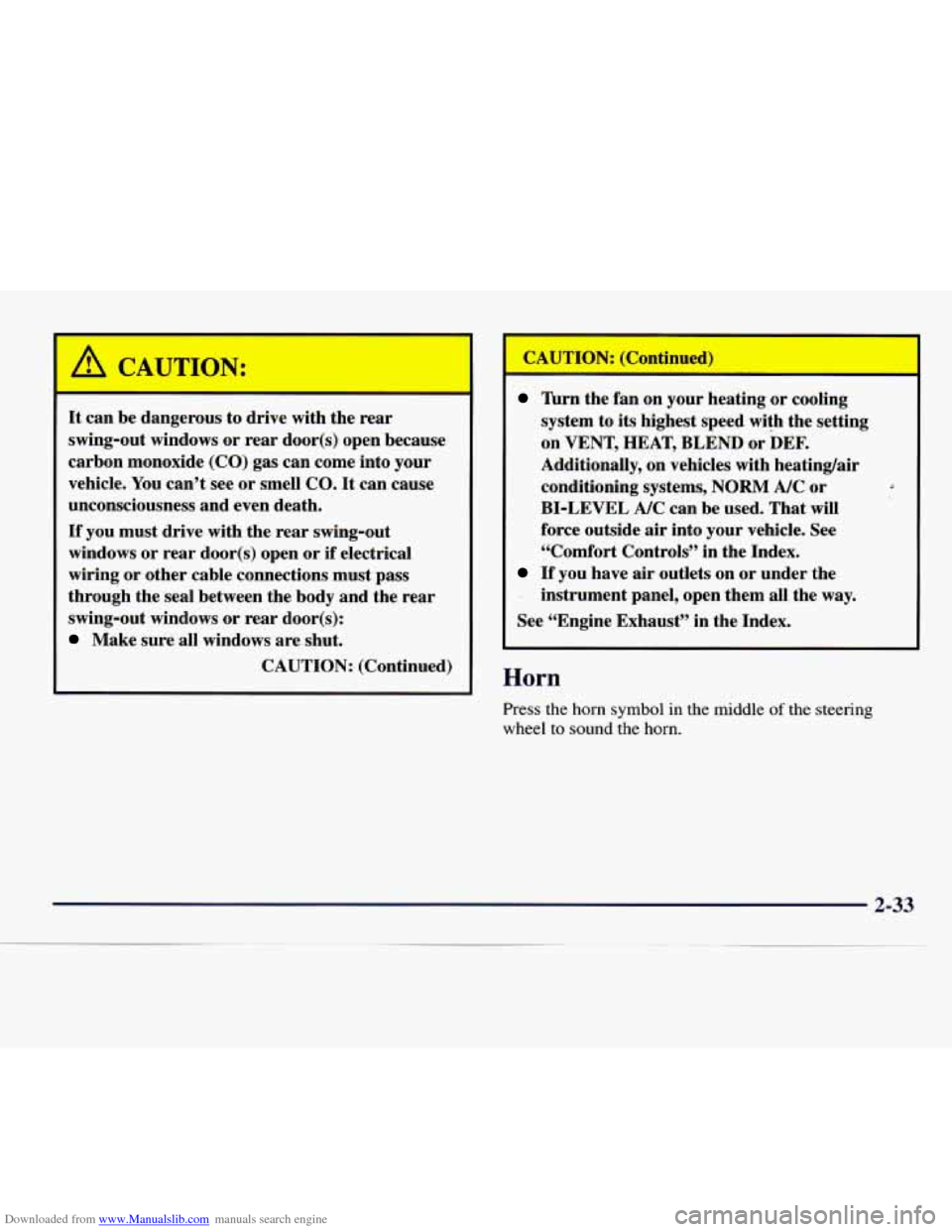
Downloaded from www.Manualslib.com manuals search engine A CAUTAN:
It can be dangerous to drive with the rear
swing-out windows or rear door(s) open because
carbon monoxide (CO) gas can come into your vehicle. You can’t see or smell CO. It can cause
unconsciousness and even death.
If you must drive with the rear swing-out
windows or rear door(s) open or if electrical
wiring or other cable connections must pass
through the seal between the body and the rear
swing-out windows or rear door(s):
Make sure all windows are shut.
CAUTION: (Continued)
I CAUTION: (Continued)
Thrn the fan on your heating or cooling
system to its highest speed with the setting
Additionally, on vehicles with heatingair
conditioning systems,
NORM A/C or
BI-LEVEL A/C can be used. That will
force outside air into your vehicle. See
“Comfort Controls” in the Index.
If you have air outlets on or under the
’. instrument panel, open them all the way.
See “Engine Exhaust” in the Index.
on
VENT, HEAT, BLEND or
DEE
Horn
Press the horn symbol in the middle of the steering
wheel to sound the horn.
Page 136 of 386

Downloaded from www.Manualslib.com manuals search engine Section 3 Comfort Controls and Audio Systems
In this section, you’ll find out how to operate the comfort control and audio systems offered with your vehicle. Be
sure to read about the particular systems supplied with your vehicle.
3-2
3-2
3-3
3-4
3-5
3-6
3-6
3-6
3-7
3-7
3-7
3-7 Comfort Controls
Heater Controls
Heater/Air Conditioning Controls
Rear Heater (Without Air Conditioning)
Rear Air Conditioning and Rear Heater
Air Conditioning
Heating Ventilation Tips
Audio Systems
Setting the Clock for Systems without
Automatic Tone Control
Setting the Clock for Systems with
Automatic Tone Control
AM-FM Stereo 3-9
3-11
3- 16
3-20
3-2
1
3-23
3-24
3-25
3-26
3-26 3-27 AM-FM
Stereo with Cassette Tape Player
(If Equipped)
AM-FM Stereo with Cassette Tape and
Automatic Tone Control (If Equipped)
AM-FM Stereo with Compact Disc Player
and Automatic Tone Control (If Equipped)
Remote Compact Disc Player (If Equipped)
Theft-Deterrent Feature
(If Equipped)
Understanding Radio Reception
Tips About Your Audio System
Care
of Your Cassette Tape Player
Care of Your Compact Discs
Care
of Your Compact Disc Player
Power Antenna Mast Care
Page 137 of 386
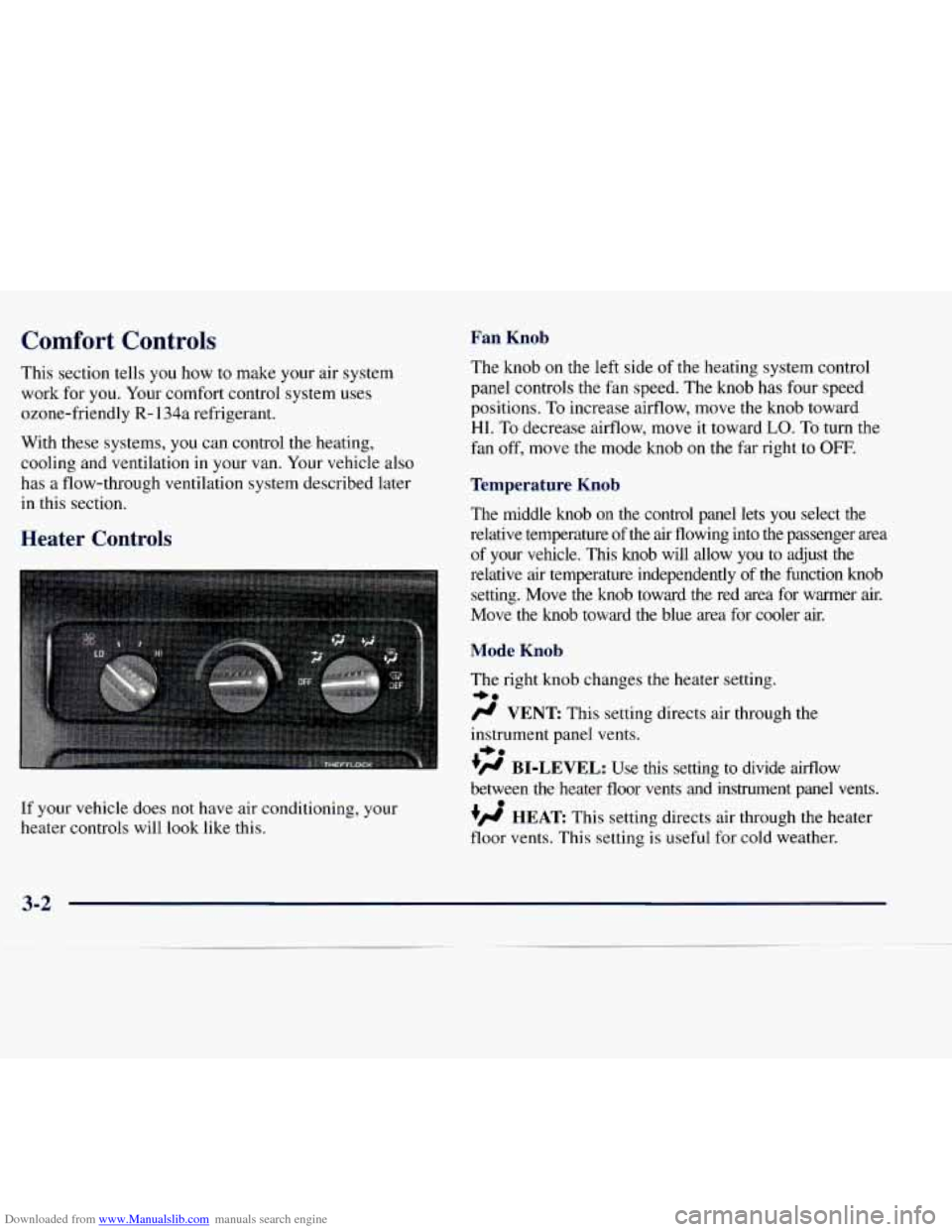
Downloaded from www.Manualslib.com manuals search engine Comfort Controls Fan Knob
This section tells you how to make your air system
work for you. Your comfort control system uses
ozone-friendly
R- 134a refrigerant.
With these systems,
you can control the heating,
cooling and ventilation in your van. Your vehicle also
has a flow-through ventilation system described later
in this section. The
knob on the left side of the heating system control
panel controls the fan speed. The knob has four speed
positions. To increase airflow, move the knob toward
HI. To decrease airflow, move it toward LO. To turn the
fan off, move the mode knob on the
far right to OFF.
Temperature Knob
The middle knob on the control panel lets you select the
relative temperature
of the air flowing into the passenger area
of your vehicle. This knob will allow you to adjust
the
Heater Controls
relative air temperature independently of the function knob
setting. Move
the knob toward the red area for warmer air.
Move the knob toward the blue area for cooler
air.
Mode Knob
If your vehicle does not have air conditioning, your
heater controls will look like this. The
right knob changes the heater setting.
+.
/J VENT This setting directs air through the
instrument panel vents.
- +.
+fl BI-LEVEL: Use this setting to divide airflow
between the heater floor vents and instrument panel vents.
+’ HEAT This setting directs air through the heater
floor vents. This setting
is useful for cold weather.
e
3-2
Page 138 of 386
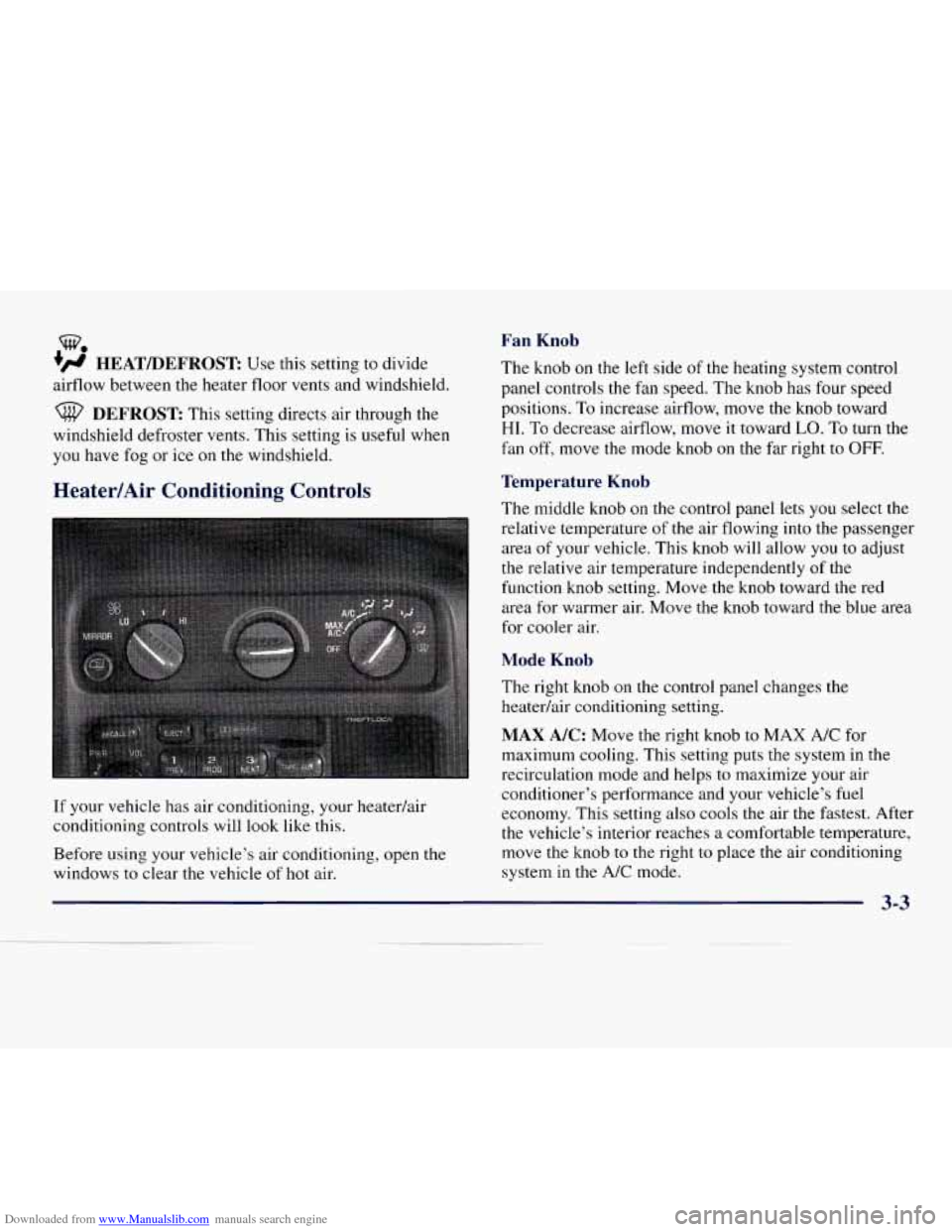
Downloaded from www.Manualslib.com manuals search engine w.
+’ HEAT/DEFROST Use this setting to divide
airflow between the heater floor vents and windshield.
DEFROST This setting directs air through the
windshield defroster vents. This setting is useful when
you have fog or ice
on the windshield.
Heater/Air Conditioning Controls
If your vehicle has air conditioning, your heatedair
conditioning controls will look like
this.
Before using your vehicle’s air conditioning, open the
windows to clear the vehicle
of hot air.
Fan Knob
The knob on the left side of the heating system control
panel controls
the fan speed. The knob has four speed
positions. To increase airflow, move the knob toward
HI. To decrease airflow, move it toward LO. To turn the
fan off, move the mode knob
on the far right to OFF.
Temperature Knob
The middle knob on the control panel lets you select the
relative temperature
of the air flowing into the passenger
area
of your vehicle. This knob will allow you to adjust
the relative air temperature independently
of the
function knob setting. Move the knob toward the red
area for warmer air. Move the knob toward the blue area
for cooler air.
Mode Knob
The right knob on the control panel changes the
heatedair conditioning setting.
MAX A/C: Move the right knob to MAX A/C for
maximum cooling. This setting puts the system in the
recirculation mode and helps
to maximize your air
conditioner’s performance and your vehicle’s fuel
economy. This setting also cools the air the fastest. After
the vehicle’s interior reaches
a comfortable temperature,
move the knob
to the right to place the air conditioning
system in the
A/C mode.
3-3
Page 139 of 386
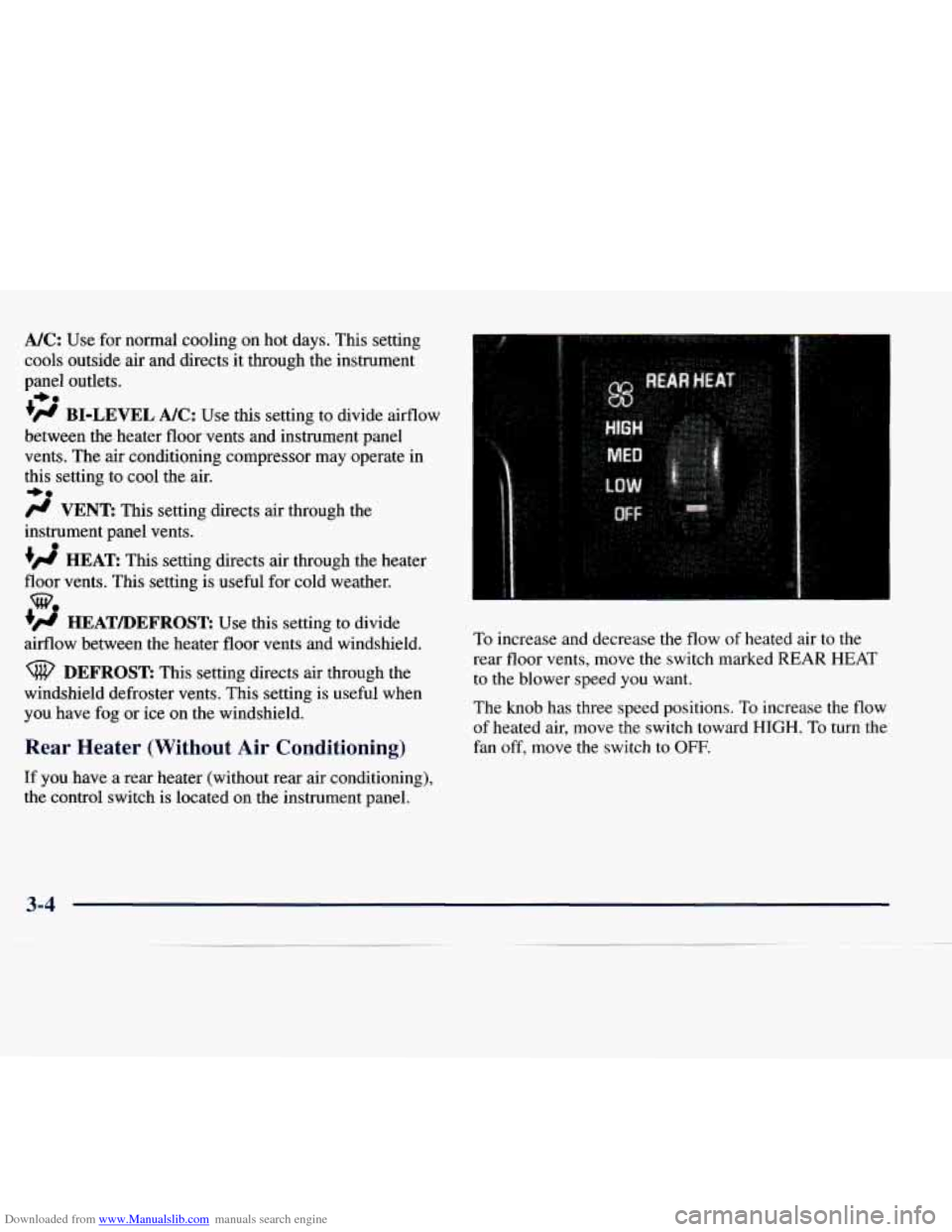
Downloaded from www.Manualslib.com manuals search engine A/C: Use for normal cooling on hot days. This setting
cools outside air and directs it through the instrument
panel outlets.
+', BI-LEVEL A/C: Use this setting to divide aifflow
between the heater floor vents and instrument panel
vents. The air conditioning compressor may operate
in
this setting to cool the air.
+e
-e
VENT: This setting directs air through the
instrument panel vents.
+H HEAT This setting directs air through the heater
floor vents. This setting
is useful for cold weather.
0
G?
HEAT/DEFROST: Use this setting to divide
aifflow between the heater floor vents and windshield.
DEFROST: This setting directs air through the
windshield defroster vents. This setting is useful when
you have fog or ice on the windshield.
Rear Heater (Without Air Conditioning)
If you have a rear heater (without rear air conditioning),
the control switch is located on
the instrument panel. To
increase and decrease the flow
of heated air to the
rear floor vents, move the switch marked REAR HEAT
to the blower speed
you want.
The
knob has three speed positions. To increase the flow
of heated air, move the switch toward HIGH. To turn the
fan
off, move the switch to OFF.
3-4
Page 140 of 386
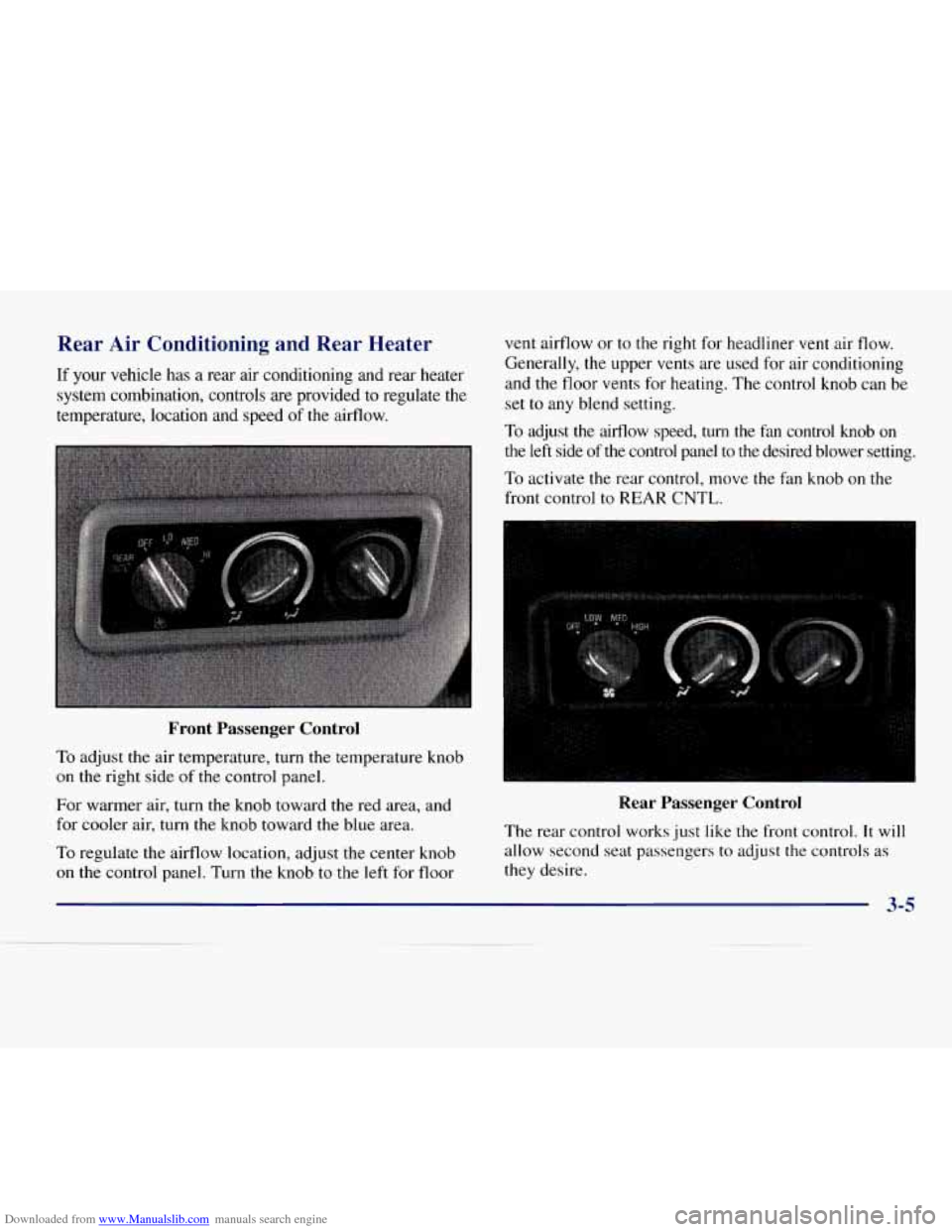
Downloaded from www.Manualslib.com manuals search engine Rear Air Conditioning and Rear Heater
If your vehicle has a rear air conditioning and rear heater
system combination, controls are provided to regulate the
temperature, location and speed
of the airflow.
Front Passenger Control
To adjust the air temperature, turn the temperature knob
on the right side
of the control panel.
For warmer air, turn the knob toward the red area, and
for cooler air, turn the knob toward the blue area.
To regulate the airflow location, adjust the center knob
on the control panel. Turn the knob to the left for floor vent airflow
or to the right for headliner
vent air flow.
Generally, the upper vents are used for air conditioning
and the
floor vents for heating. The control knob can be
set to any blend setting.
To adjust the
airflow speed, turn the fan control knob on
the left side of the control panel to the desired blower setting.
To activate the rear control, move the fan knob on the
front control to REAR CNTL.
Rear Passenger Control
The rear control works just like the front control. It will
allow second seat passengers
to adjust the controls as
they desire.
Page 141 of 386
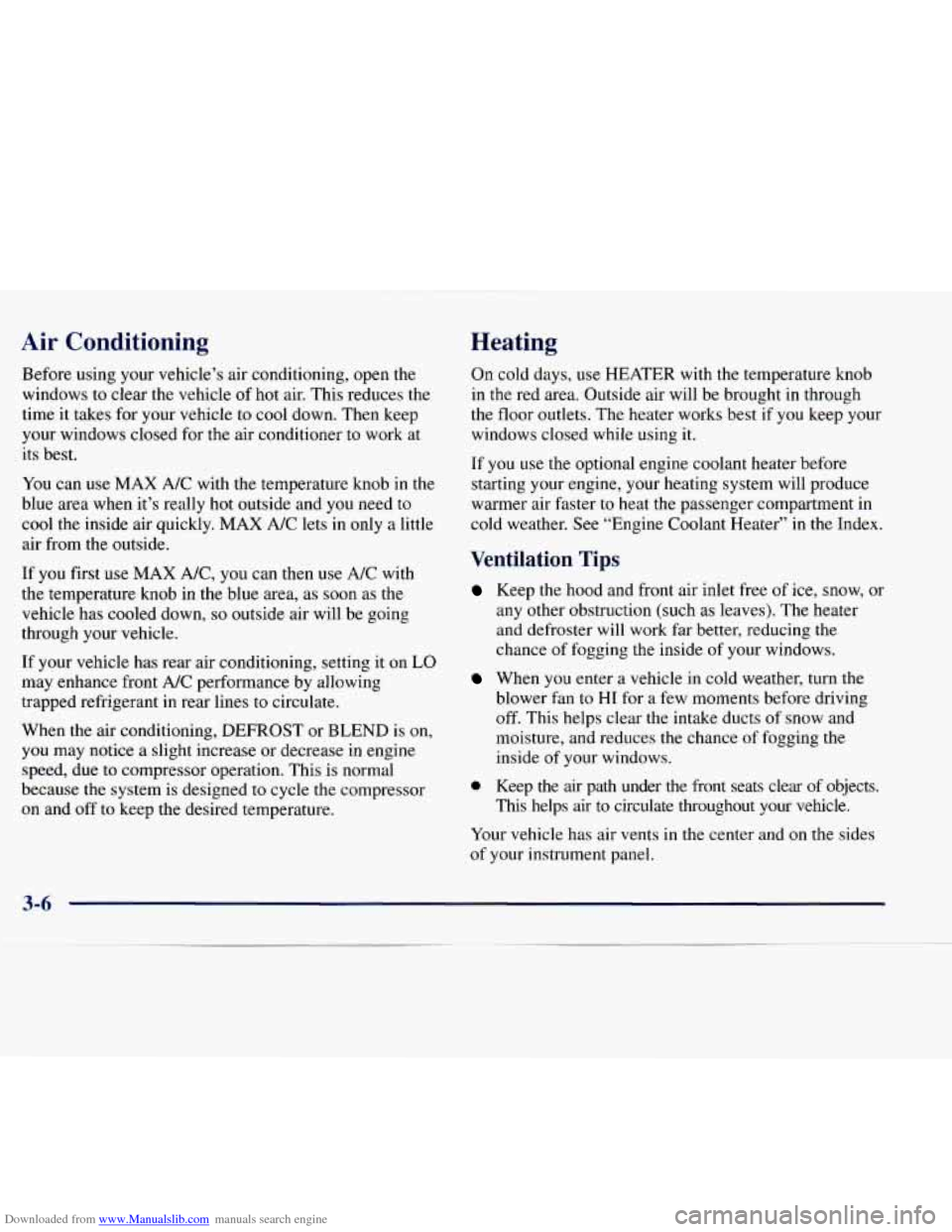
Downloaded from www.Manualslib.com manuals search engine Air Conditioning 1 ~ ~ ting
Before using your vehicle’s air conditioning, open the
windows to clear the vehicle
of hot air. This reduces the
time it takes for your vehicle to cool down. Then keep
your windows closed for the air conditioner to work at
its best.
You can use
MAX A/C with the temperature knob in the
blue area when it’s really hot outside and you need to
cool the inside air quickly. MAX A/C lets in only a little
air from the outside.
If you first use MAX A/C, you can then use A/C with
the temperature knob in the blue area, as soon as
the
vehicle has cooled down, so outside air will be going
through your vehicle.
If your vehicle has rear air conditioning, setting
it on LO
may enhance front A/C performance by allowing
trapped refrigerant in rear lines
to circulate.
When the air conditioning, DEFROST or
BLEND is on,
you may notice
a slight increase or decrease in engine
speed, due to compressor operation. This is normal
because the system is designed
to cycle the compressor
on and off
to keep the desired temperature. On
cold days,
use HEATER with the temperature knob
in the red area. Outside air will be brought in through
the floor outlets. The heater works best
if you keep your
windows closed while using it.
If you
use the optional engine coolant heater before
starting your engine, your heating system will produce
warmer air faster to heat the passenger compartment in
cold weather. See “Engine Coolant Heater”
in the Index.
Ventilation Tips
Keep the hood and front air inlet free of ice, snow, or
any other obstruction (such as leaves). The heater
and defroster will work far better, reducing the
chance
of fogging the inside of your windows.
When you enter a vehicle in cold weather, turn the
blower fan to HI for a few moments before driving
off. This helps clear the intake ducts
of snow and
moisture, and reduces the chance of fogging the
inside
of your windows.
0 Keep the air path under the front seats clear of objects.
This helps air to circulate throughout your vehicle.
Your vehicle has air vents in the center and
on the sides
of your instrument panel.
3-6